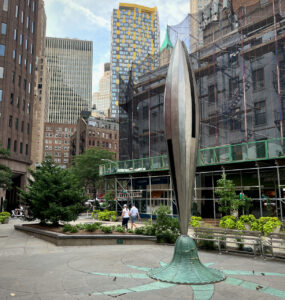
Coenties Slip. Photo by John Griswold
The feeling comes over me at unexpected times—walking down a street of stone townhomes at dawn, lights in bay windows, stairs and gardens mounded with new snow. Sensing that the skyscraper-as-public-art was designed instead as a taunt and a cashing-in on disaster. Leafing through a glossy magazine filled with photos of socialites smiling as if they fear the spinach canapés are visible in their teeth.
The feeling is not about being shut out; it is not about money. It is closer to Hemingway’s feeling of “the death loneliness that comes at the end of every day that is wasted in your life.” His was about social neurosis and making art. Mine, I think, is about the lie that things are settled and in their eternal forms—that past, future, and the rest of the world do not matter.
I think too often of the woman on social media who put all her books on the shelf with spines facing the wall so they were less distracting.
The antidote is finding places where time, distance, and forces with changing vectors are not purposely hidden, where there are multiple uses, not hoarded ones. Difference makes life worth living.
In Manhattan last week I kept getting impressionistic jots of that positive feeling:
Standing on a subway platform as a train roared and squealed to a stop on the opposite track, a man who must have been 100 sitting alone in the lighted car, looking out with interest. Everyone, hundreds of people, at the stop were younger than him by decades. The chalky aluminum skin of the subway car was painted with an American flag, and he was an astronaut in a lunar lander.
Three young women and a young man in that Korean place, dressed up, wearing expensive watches, sat talking pleasurably and laughing at a table of empty bottles and half-finished plates. The restaurant was excellent, a passion project of a younger generation, but it had not been there long, and all owners know the odds. The four were no more than a couple of years past college graduation. I would like to have asked them enough questions to know the texture of their minds, how they were doing, whether they were alive on 9-11, what they believed about the future, but it was a nice evening. Outside the city rose and fell and rose.
I also got to do something I have long wanted to do in New York—visit some of the places Herman Melville mentions in his work. Ishmael starts his story by telling how the flatness of life sometimes becomes too much. In his first chapter, “Loomings,” he feels belligerent enough in his entrapment that he thinks about knocking other people’s hats off their heads in the street but instead feels fellow sympathy for their quiet desperation, by which they gather for reasons they do not understand to stare at the sea.
One of the places Ishmael mentions in his “circumambulation” of the “insular city of the Manhattoes” is Coenties Slip. I had no hopes that it—whatever it was—still existed on digital maps. I followed Ishmael’s notes down by Battery Park, past the wharves belting the island like a coral reef, along Whitehall, and was delighted that Coenties Slip is still with us after almost 175 years, though “thousands upon thousands of mortal men fixed in ocean reveries” “like silent sentinels” no longer congregate at spots like this. They are up in the One World Observatory looming over the city, or riding the fleet of ferries as regular as subway trains, looking at the skyline.
The “slip” was originally a dredged inlet, or even just a wharf, on the East River, where for a while, after 1825 when the Erie Canal was finished, canal boats were stored. By the time Melville was writing his novel, the slip had been backfilled and developed, and those buildings were already destroyed in the Great Fire.
Now Coenties Slip is a small road, almost an alleyway, between Water Street and Pearl. Buildings nearby may have been there since Moby Dick was published, but their occupants are businesses with names such as Perfect Brows, NYC Convenience, and 3 Times Dim Sum. I sat with a friend outside the Shanghainese restaurant and ate, watching aging skateboarders grind around a public sculpture also named Coenties Slip. Something relaxed in me, and I felt the positive form of my feeling, not the negative. I was in Ishmael’s city briefly and have lived on his prairies knee-deep in Tiger Lilies. It was just another layer of impression, but layers and texture sometimes offer the blessing of sensing other, endless, depths.
